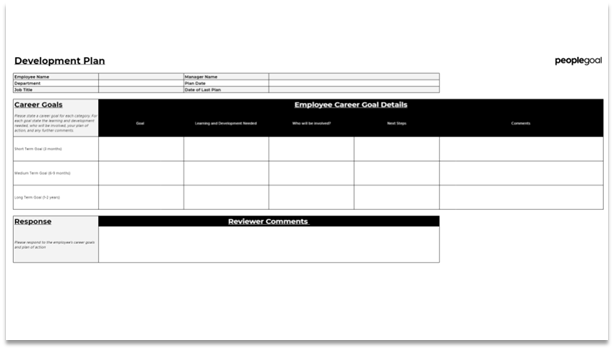SORRY, but losing your best employee isn’t bad luck. You are handing them over to your competitors due to a weak employee development plan. Yeah, even your brightest stars won’t wait around; they’ll walk straight into a company that actually invests in their future.
Here’s the twist: fixing it is easier than you think, and the payoff is massive.
Over the last decade, I’ve worked with 200+ organizations, helping them cut turnover by 18% and increase internal promotions by 25%; all by structuring growth instead of guessing.
By this experience, here’s a blog that will help you discover:
- How to design development plans that actually stick.
- Proven templates and examples you can adapt instantly.
- Metrics to track success and prove ROI.
Follow the plan, and you can expect employees to stay longer, leaders to rise faster, and your bottom line to grow stronger.
Ready to learn more? Let’s start with a very basic question first:
What Is an Employee Development Plan?
An employee development plan is a detailed framework that connects an employee’s career aspirations with the company’s long-term objectives. It goes beyond simple training sessions by laying out specific goals, identifying the skills needed to achieve them, and mapping the resources or opportunities that will support progress.
Unlike one-off workshops, the plan provides structure and direction. It sets milestones, clarifies responsibilities, and measures growth over time.

And whether it is framed as part of a broader career development plan for employees or built into an Individual Development Plan (IDP), the outcome is the same: personal growth tied directly to measurable business value.
After defining what an employee development plan is, the natural step forward is to understand exactly how you can build one from the ground up.
Let me walk you through the process step by step, with the same depth I use when helping managers implement plans that work.
How To Create an Employee Development Plan
Creating an employee development plan requires more than filling out a form. It is about designing a structured path that blends business strategy with personal growth.
Let’s go step by step through the process of building a career development plan for employees that actually works in practice.
Step 1: Connect the Plan Directly to Business Strategy
Every plan must start with business priorities.
If the company goal is to expand into a new region, the development plan for a sales manager has to prepare them for cross-border negotiations and client acquisition.
I have seen managers fail when plans were built in isolation, so my first rule is always “clarity before activity.” When you link goals and objectives to strategy, employees understand their purpose and work with more focus.
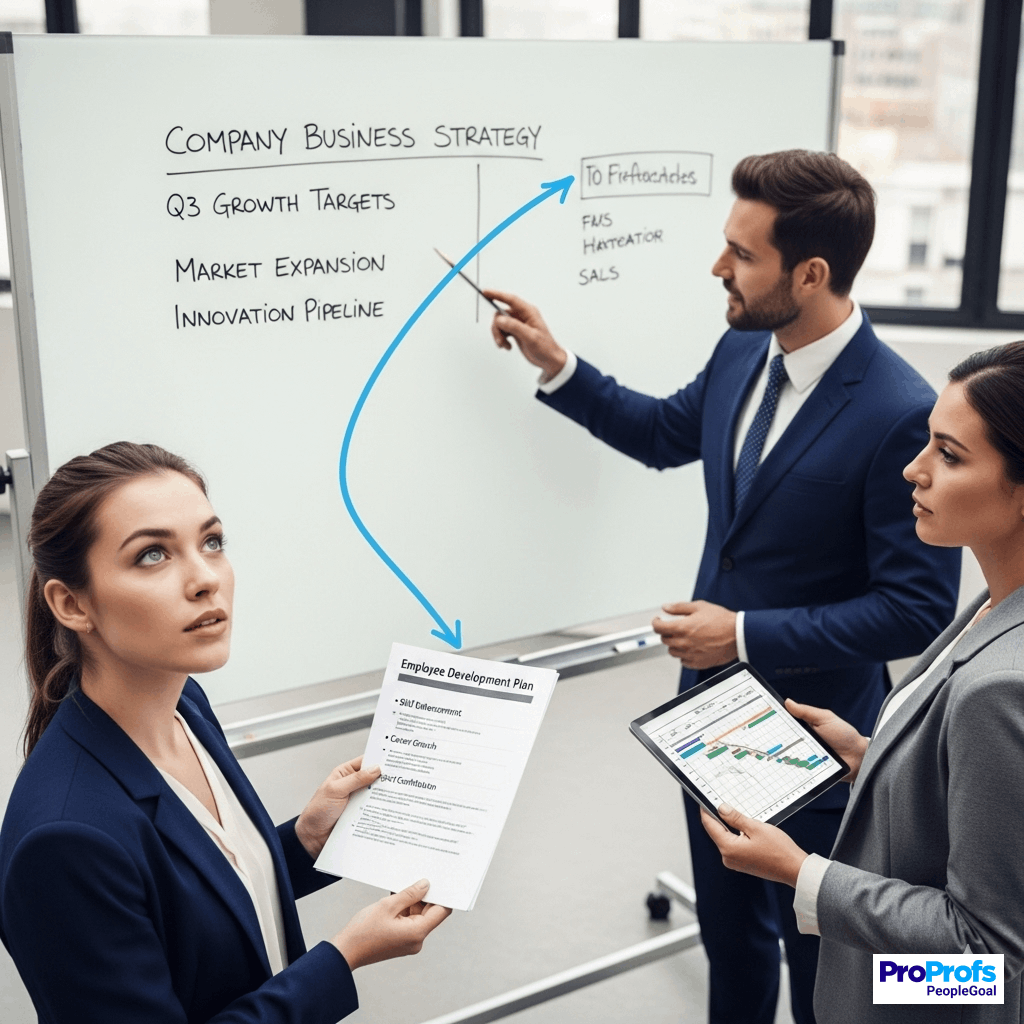
You can use the following practical approaches:
- Map each role outcome directly to one business metric. For instance, I tied a customer support team’s plan to first response time, which made their training sessions on ticket management tools far more relevant.
- Document two or three risks that could block progress and add preventive actions. In one case, I identified a knowledge gap on new product features and arranged early training with the product team.
- Use data that already exists. I once relied on client renewal data to track whether new account management training was paying off, and it gave leadership confidence in the plan.
Step 2: Assess Current Skills and Identify Gaps With Precision
Once you know what the business needs, you must understand what the employee can already do. This is where a structured assessment comes in.
When I conduct these, I pull from recent projects, run one-on-one meetings, and gather peer feedback. The result is a clear picture of strengths, weaknesses, and the exact skills gap that has to be closed.
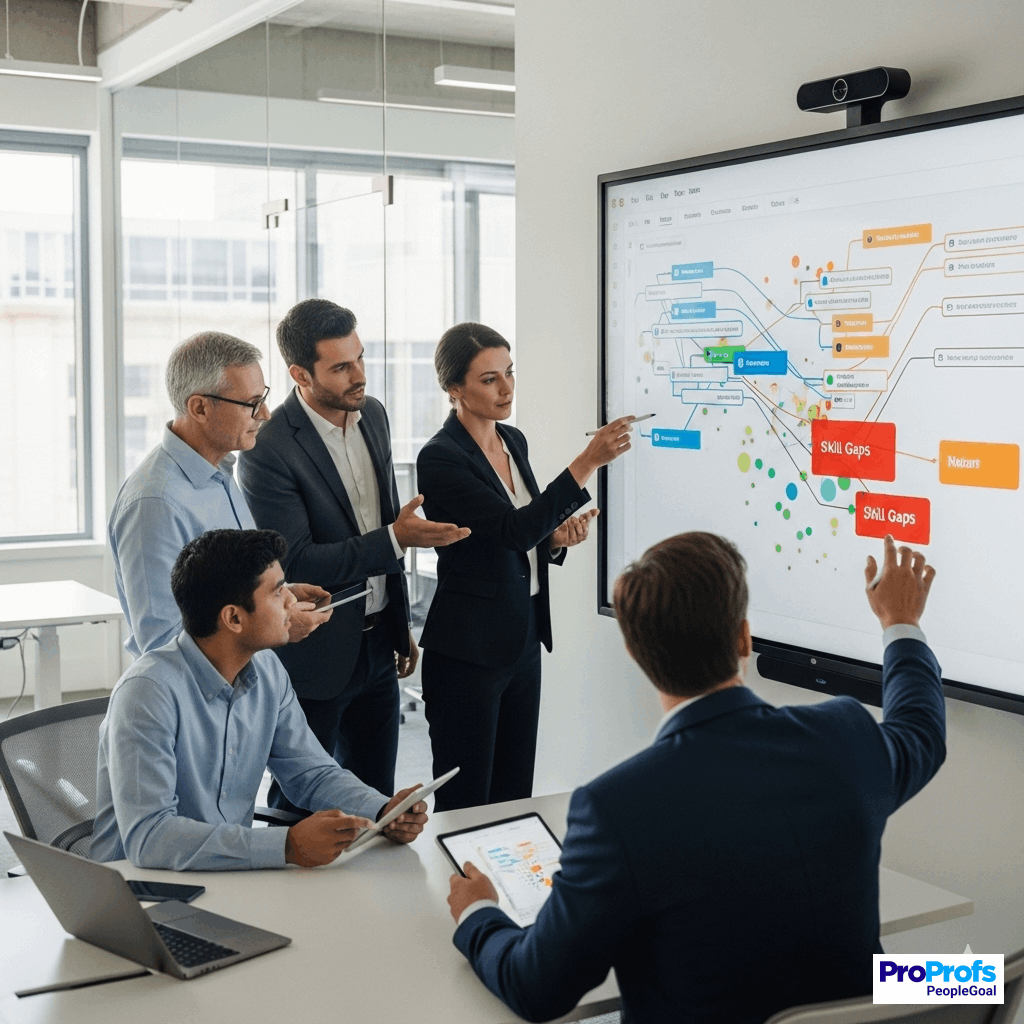
You can take the following steps:
- Collect evidence from actual work. For example, when reviewing a marketing manager’s campaign reports, I noticed weak data analysis, which became a development priority.
- Ask peers and stakeholders for specific feedback on results. A colleague once told me, “She’s great at ideas, but her execution is inconsistent,” which gave us a clear focus area.
- Compare capabilities against a competency framework. I have used this to show engineers where they stood on problem-solving versus leadership skills, which shifted their training focus.
Step 3: Set SMART Goals That Drive Measurable Change
With gaps identified, you then translate them into SMART goals. These should be specific, measurable, achievable, relevant, and time-bound. Without SMART goals, plans tend to drift into wish lists. I always remind managers that fewer, sharper goals lead to better results.

Examples of development goals for employees include:
- Lead one cross-functional project in the next quarter, reducing rework by 15 percent with a new handoff checklist.
- Complete a set of customer interviews in 30 days and deliver a proposal to cut churn by 2 percent.
- Mentor two junior employees for eight weeks and shorten their onboarding time by 20 percent.
In my own practice, I once set a goal for a junior analyst to present insights at the next leadership meeting. Not only did the analyst sharpen their communication skills, but the leadership team also gained a valuable new perspective.
Step 4: Design a Comprehensive Learning Path With Practice Opportunities
A plan is not complete without a learning path that blends training programs, mentorship, and coaching with real-world practice. I have learned that training without application rarely sticks. Upskilling and reskilling work best when employees apply learning immediately.
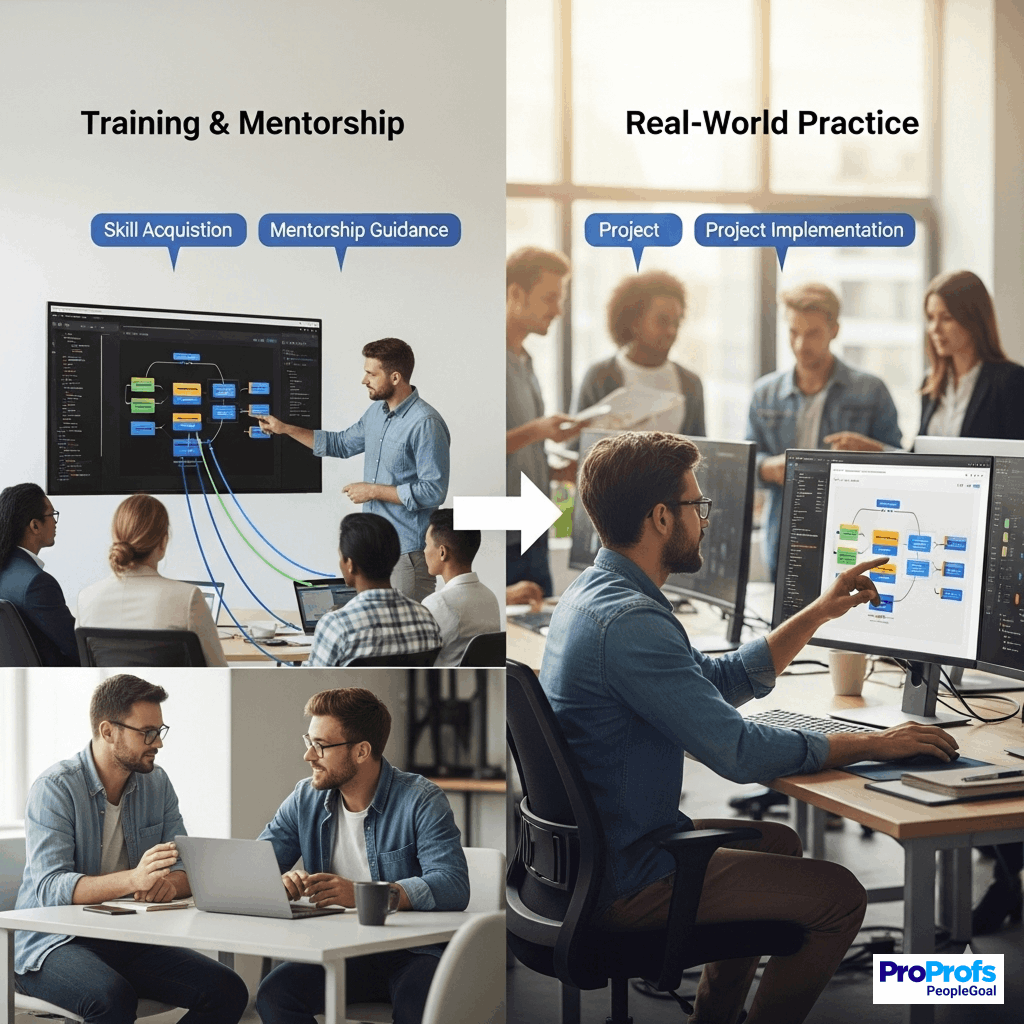
You can build the path in the following ways:
- Pair formal training with live projects. After one of my managers finished a negotiation workshop, I scheduled them for a high-stakes client call the same week.
- Provide mentors and coaches with structured cadences. I once matched a new team lead with a senior manager, and within months, she was handling difficult feedback sessions with confidence.
- Use controlled stretch projects. In one case, I gave a developer ownership of a pilot project. He learned leadership skills, and the company gained a new automation tool.
Step 5: Establish a Clear System for Execution and Review
Even the best plan will fail if it is not executed consistently. That is why you need a clear operating rhythm: meetings, feedback cycles, and documentation that keep progress visible. This is where your employee training and development plan becomes real.
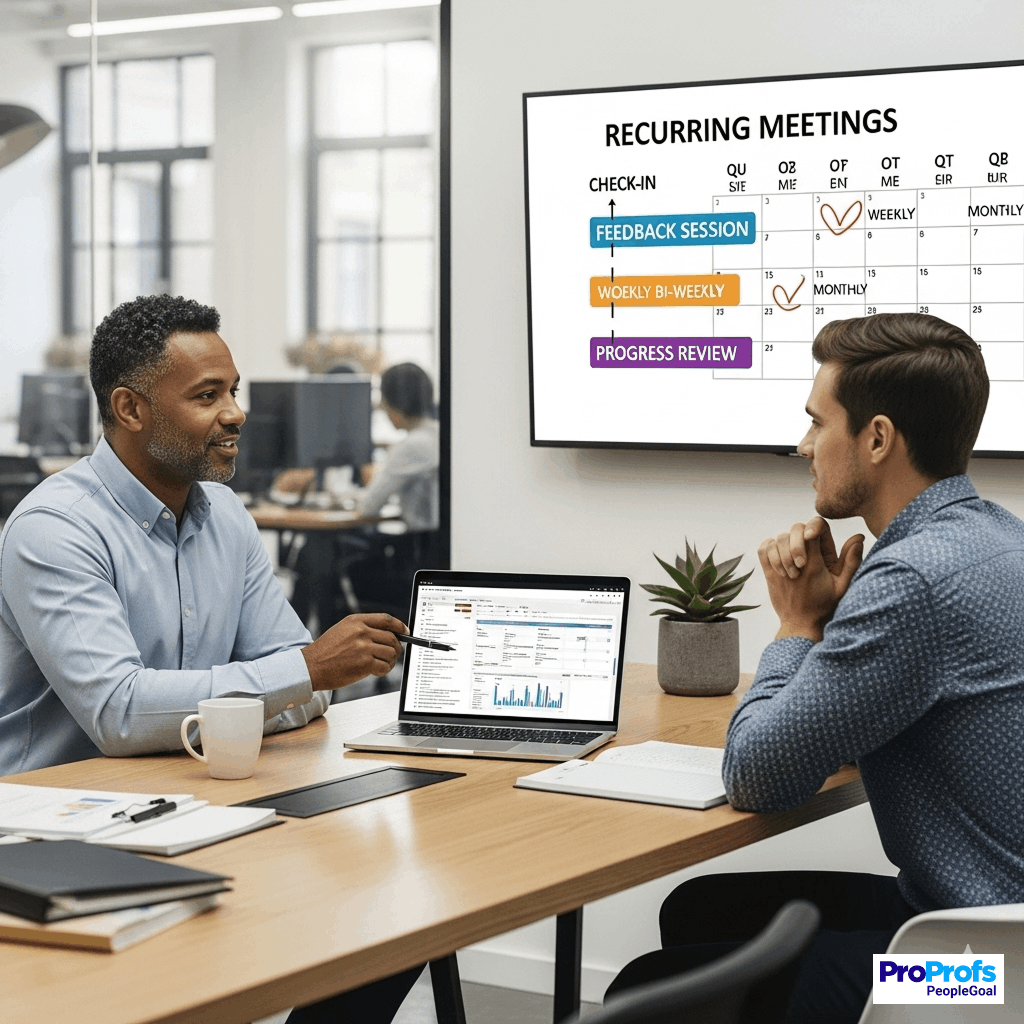
You can structure this system with the following:
- Write down goals with timelines and metrics. I once used a shared dashboard to track sales training progress, and the visibility kept everyone accountable.
- Assign mentors and schedule regular one-on-one meetings. Blocking time on calendars made sure learning was never skipped.
- Note risks and proactive solutions. For example, I added “lack of time” as a risk and solved it by assigning two hours weekly just for training.
Step 6: Review Progress Regularly and Adapt the Plan When Needed
An employee development plan should never be static. I usually recommend monthly check-ins and quarterly resets. These reviews allow you to evaluate what is working, adapt where necessary, and recognize achievements. Employees appreciate when their progress is visible and acknowledged.
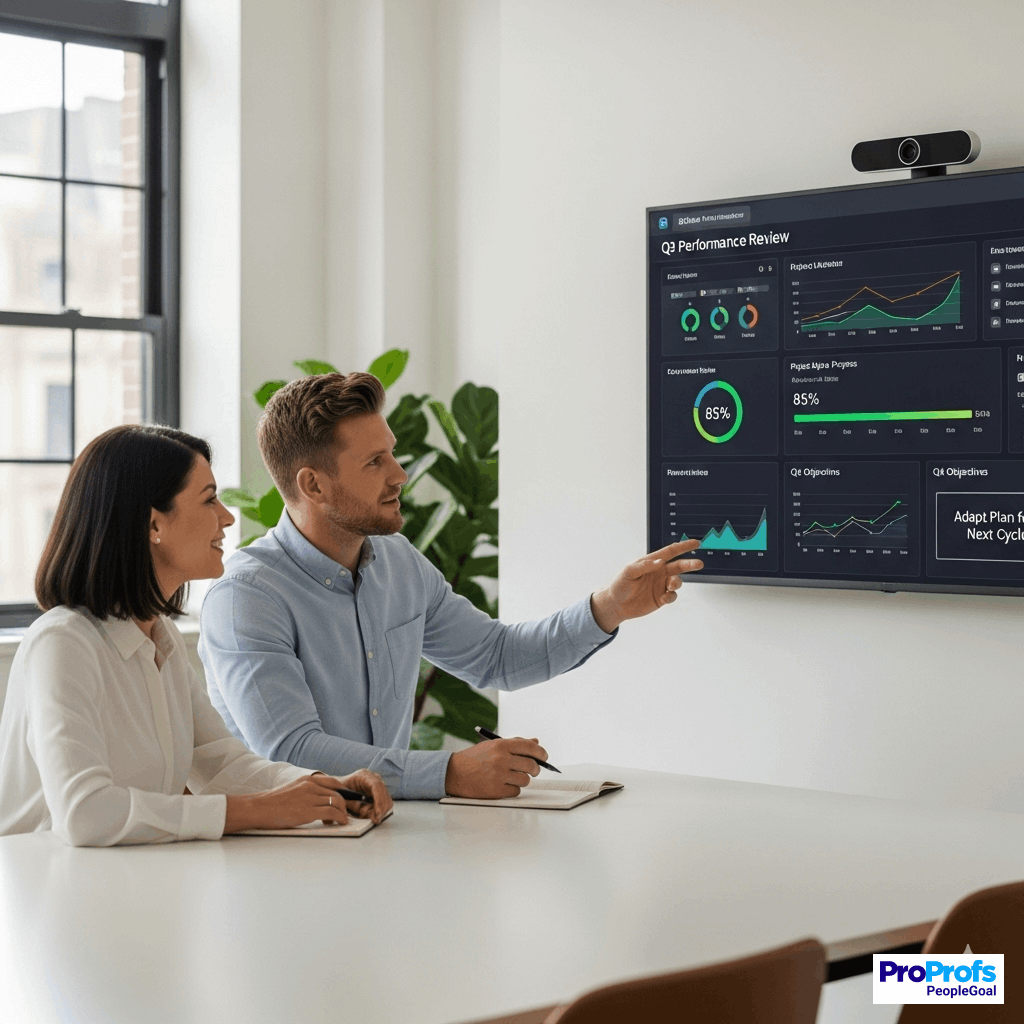
Consider the following signals when reviewing:
- Positive signs include measurable progress on goals and consistent application of skills.
- Warning signs include activity without results or repeated blockers.
- Red flags include stalled goals and no evidence of skill application.
I once worked with a project manager whose training efforts were strong, but application lagged. We solved it by pairing her with a peer for a live project, and within weeks her confidence and output improved.
Step 7: Capture Results and Scale What Works Across Teams
The last step is to close the loop. You document results, highlight success stories, and store examples so that future managers can reuse them. This turns one successful plan into a repeatable model across your workforce.
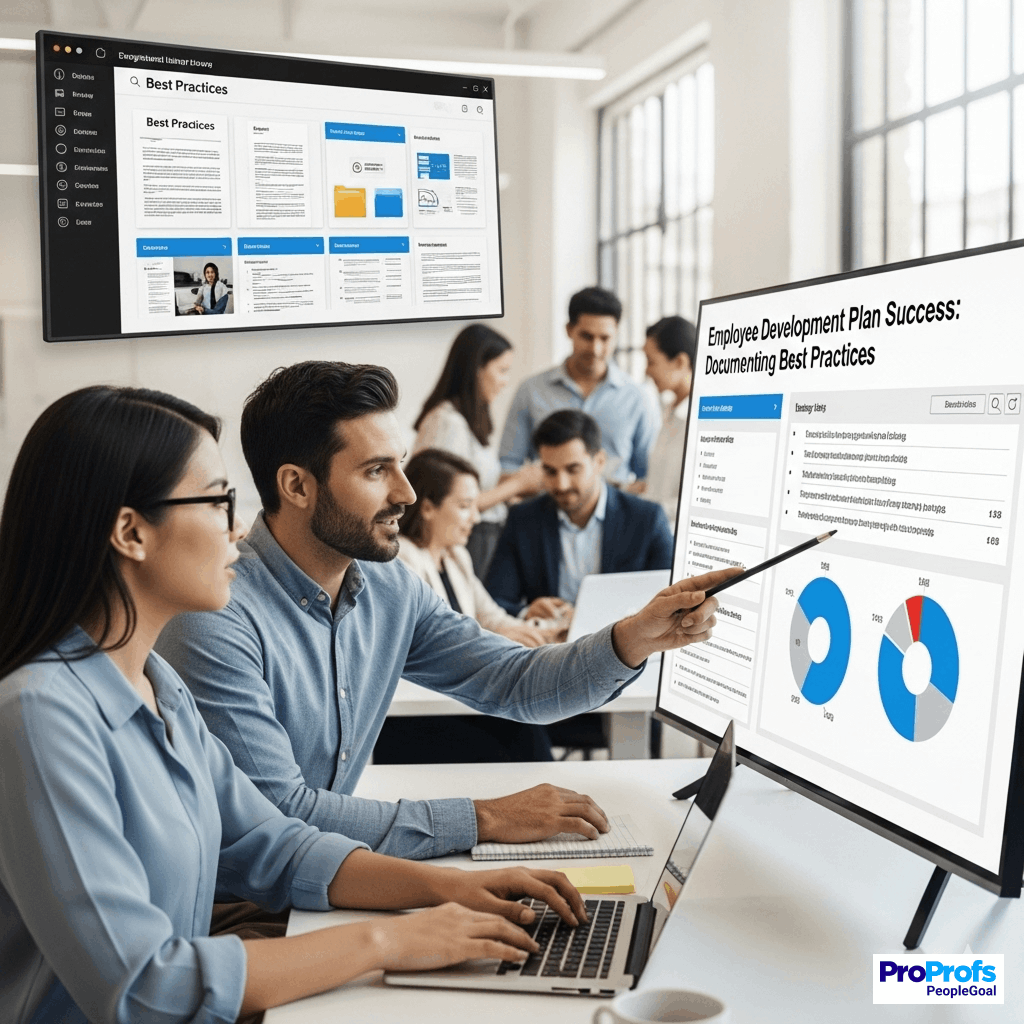
You can do this effectively by:
- Summarize each plan’s results in a one-page format for leadership review.
- Creating a library of sample plans by role. When I did this, new managers were able to launch plans in half the time.
- Sharing stories of employee progress. One of my team members told me, “Seeing last year’s plan next to this year’s made me realize how far I’ve come.” That kind of storytelling builds belief in the process.
Sounds good?
Now, here’s a quick video you can watch to know better about how employee development software can help you get a better understanding of the process:
Why Employee Development Plans Matter
An employee development plan is not just a professional courtesy; it is a business advantage. When you invest in a structured employee growth plan, you improve both the employee’s experience and the company’s long-term outcomes.
I have seen organizations transform their culture simply by moving from ad-hoc training to a consistent employee development program. The shift brings focus, fairness, and accountability.
The most immediate benefit is employee engagement. When people see that their employer cares about their progress, they show up with more energy and commitment.
I once heard a team member say, “I stay here because my manager always makes time for my growth.” That statement captured the connection between development and loyalty better than any survey. Engagement then leads to higher employee retention, saving the company from the cost and disruption of turnover.
Sounds good? Here’s something more interesting:
Development plans also create visible career paths and opportunities for career progression. Instead of wondering what comes next, employees see a structured roadmap.
For example, I worked with a finance analyst who had ambitions for leadership. Through a carefully designed career growth plan, we mapped the skills he needed: public speaking, strategic analysis, and cross-department collaboration.
Within eighteen months, he was promoted to a senior role. His journey showed others that the system worked.
Another critical outcome is succession planning. When senior leaders retire or move on, you want a ready pool of talent to step in.
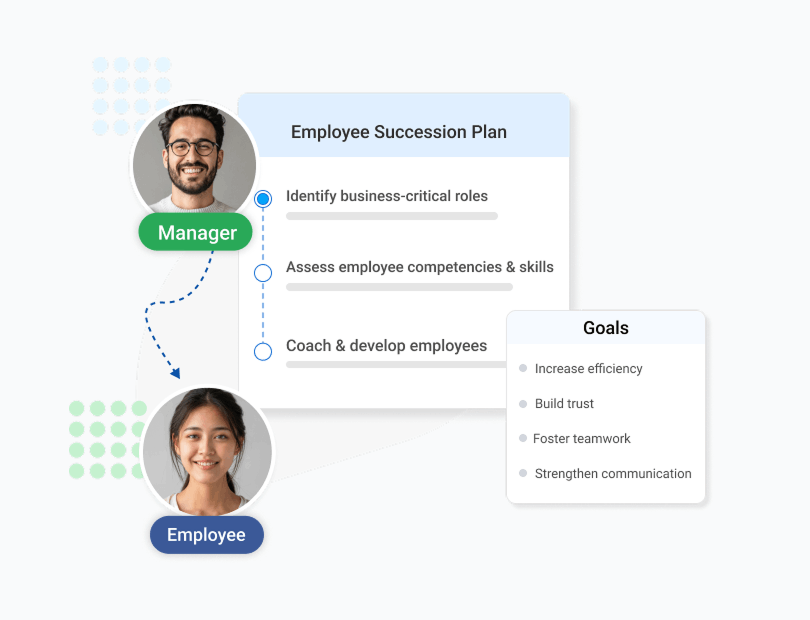
By embedding employee success plans into your workforce, you develop leaders before you need them. I once guided a technology firm through this process, and when a director left unexpectedly, one of the managers we had prepared through the plan was ready to take over smoothly.
Finally, structured development enhances the overall employee experience. People do not want to feel like replaceable parts. They want to feel that their work is building toward something meaningful.
When you provide that through an employee development program, you do more than improve performance; you build a workplace where people want to stay and grow.
And what about the returns?
The return is measurable, too. Studies consistently show that investment in development improves retention, productivity, and morale.
In my own practice, I calculate the ROI of employee development by comparing turnover before and after implementing plans. In one case, turnover dropped by 12 percent in a single year, which translated into hundreds of thousands of dollars saved.
When you connect the dots, the message is clear: development plans matter because they create engaged employees, retain talent, prepare future leaders, and make work more rewarding. This is not a side initiative; it is the foundation of long-term success for both people and organizations.
Sounds good?
Now that you know why employee development plans matter, it is equally important to clear up a very common point of confusion.
Many leaders mistake an employee development plan for a performance improvement plan, when in reality they serve very different purposes.
Employee Development Plan vs Performance Improvement Plan (PIP)
An employee development plan is proactive. It exists to build skills, prepare employees for future roles, and connect individual growth with organizational strategy.
By contrast, a Performance Improvement Plan (PIP) is corrective. It is used when an employee’s performance has dropped below expectations and urgent action is required to bring it back on track.
I have often seen organizations use the wrong approach at the wrong time.
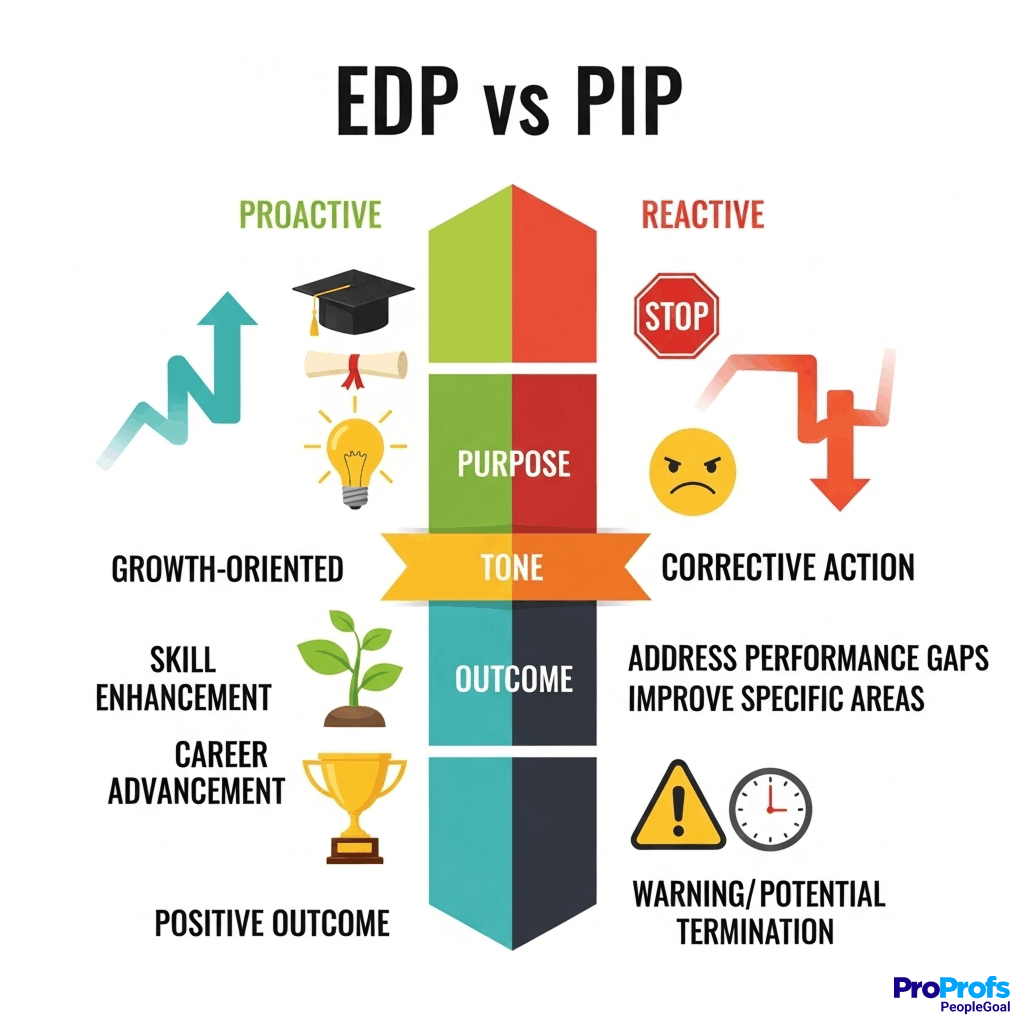
For example, a manager once asked me if we should put a high-potential employee on a PIP because she lacked presentation skills. My response was simple: “She does not need correction; she needs growth.”
We built an employee improvement plan instead, including public speaking workshops and mentoring, and within months, she was confidently leading client pitches. That is why distinguishing between the two is so critical.
Here is a clear side-by-side comparison:
| Aspect | Employee Development Plan | Performance Improvement Plan (PIP) |
|---|---|---|
| Purpose | To enhance skills, promote career growth, and prepare employees for future roles. | To address and correct underperformance or behavioral issues. |
| Trigger | Regular reviews, career aspirations, or succession planning. | Consistent performance gaps or failure to meet expectations. |
| Tone | Supportive and future-focused, often part of a broader development plan for employees. | Corrective and urgent, focused on immediate improvement. |
| Ownership | Shared between employee and employer, often tied to a career development plan for employees or a professional development plan. | Primarily employer-driven, with clear non-compliance consequences. |
| Timeline | Long-term, reviewed regularly as part of strategy. | Short-term, with specific deadlines to meet minimum standards. |
| Outcomes | Growth, readiness for promotions, stronger skills, and improved engagement. | Either improvement to acceptable standards or potential termination. |
When you explain it in this way, managers realize the two tools serve completely different purposes.
An employee development plan supports potential, while a PIP addresses performance problems. Using them correctly protects morale, keeps trust intact, and ensures the right employees receive the right type of guidance at the right time.
After distinguishing between development plans and PIPs, the most practical thing you can use is a readymade employee development plan template.
Here are some of them in a structured format you can apply directly in your workplace. Just copy the one you need and paste it to start working.
Employee Development Plan Templates
1. Basic Role-Based Plan Template
This template is best for everyday use across all departments. It helps managers capture goals, track status, and document both achievements and areas for growth. It works well for mid-year or annual reviews and ensures conversations stay structured instead of vague.
Template
Employee Name: ______________________
Department/Team: ____________________
Manager Name: _______________________
Review Period: _______________________
A. Goal Status Summary
| Goal | Target Outcome | Status | Notes |
| Goal 1 | _________________________ | Achieved / In Progress / Blocked | _________ |
| Goal 2 | _________________________ | Achieved / In Progress / Blocked | _________ |
| Goal 3 | _________________________ | Achieved / In Progress / Blocked | _________ |
B. Key Wins This Period
C. Areas for Improvement
D. Manager Comments
E. Employee Reflection (Optional)
Signatures:
Employee: __________________ Date: _______
Manager: __________________ Date: _______
2. New Employee Development Plan Template
This template is designed for onboarding. It helps new hires build confidence, track early progress, and integrate into the team smoothly. Use it within the first 90 days to set the right tone.
Template
Employee Name: ______________________
Start Date: __________________________
Department/Team: ____________________
Manager Name: _______________________
A. Orientation Goals (First 30 Days)
B. Short-Term Skills Focus (First 90 Days)
C. Assigned Mentor/Buddy: __________________________
D. Training and Learning Modules
| Module | Resource/Link | Completion Date | Status |
| ______ | _____________ | _______________ | Pending/In Progress/Done |
| ______ | _____________ | _______________ | Pending/In Progress/Done |
E. Check-In Schedule
☐ Weekly
☐ Biweekly
☐ Monthly
F. Review of Onboarding Progress
Signatures:
Employee: __________________ Date: _______
Manager: __________________ Date: _______
3. Career Development Plan for Employees Template
This template supports long-term growth and promotions. It maps out career aspirations and highlights the skill gaps employees need to close to reach the next level.
Template
Employee Name: ______________________
Current Role: ________________________
Target Role: _________________________
Manager Name: _______________________
A. Career Aspirations Statement
B. Skills Gap Analysis
| Current Skills | Required Skills | Gap? | Development Action |
| ______________ | _______________ | Yes/No | __________________ |
| ______________ | _______________ | Yes/No | __________________ |
C. Career Goals
- Short-Term Goals (6–12 months): ____________________________
- Long-Term Goals (2–5 years): _____________________________
D. Development Actions
E. Timeline and Success Measures
Signatures:
Employee: __________________ Date: _______
Manager: __________________ Date: _______
4. Professional Development Plan for Employees Template
This template is for employees focusing on specific technical or professional skills such as certifications, communication, or leadership.
Template
Employee Name: ______________________
Department/Team: ____________________
Manager Name: _______________________
A. Core Competencies and Skill Gaps
B. Development Goals
- Technical Skills: __________________________________________
- Soft Skills: ______________________________________________
- Leadership: ______________________________________________
C. Learning Activities
| Activity | Provider/Resource | Target Date | Completion Status |
| ________ | _________________ | ___________ | Pending/In Progress/Done |
| ________ | _________________ | ___________ | Pending/In Progress/Done |
D. Budget or Resources Needed
E. Progress Notes
Signatures:
Employee: __________________ Date: _______
Manager: __________________ Date: _______
5. Individual Development Plan (IDP) Template
Structured and widely used in enterprises, this template aligns employee goals with organizational frameworks and competencies.
Template
Employee Name: ______________________
Position: ____________________________
Years in Service: ____________________
Manager Name: _______________________
A. Career Goals
- Short-Term: _____________________________________________
- Long-Term: ______________________________________________
B. Competency Framework Review
| Competency | Current Rating (1–5) | Target Rating | Development Action |
| __________ | ____________________ | _____________ | _________________ |
| __________ | ____________________ | _____________ | _________________ |
C. Development Actions
D. Review Schedule
☐ Quarterly
☐ Semi-Annual
☐ Annual
E. Evaluation Notes
Signatures:
Employee: __________________ Date: _______
Manager: __________________ Date: _______
HR: ________________________ Date: _______
6. Employee Training and Development Plan Template
This template focuses heavily on structured training programs and progress tracking.
Template
Employee Name: ______________________
Position: ____________________________
Training Period: _____________________
Manager Name: _______________________
A. Training Goals and Objectives
B. Training Modules
| Module | Provider | Duration | Status |
| ______ | ________ | ________ | Pending/In Progress/Done |
| ______ | ________ | ________ | Pending/In Progress/Done |
C. Practice Assignments and Deliverables
D. Evaluation Criteria
E. Feedback Log
Signatures:
Employee: __________________ Date: _______
Manager: __________________ Date: _______
7. Five-Year Employee Development Plan Template
This template is for long-term career growth and succession planning, giving employees and leaders a multi-year roadmap.
Template
Employee Name: ______________________
Department/Team: ____________________
Manager Name: _______________________
A. Five-Year Vision Statement
B. Annual Goals and Objectives
| Year | Major Goal | Development Actions | Milestones |
| 1 | ___________ | ____________________ | __________ |
| 2 | ___________ | ____________________ | __________ |
| 3 | ___________ | ____________________ | __________ |
| 4 | ___________ | ____________________ | __________ |
| 5 | ___________ | ____________________ | __________ |
C. Key Skills to Build Each Year
D. Succession Planning Notes
Signatures:
Employee: __________________ Date: _______
Manager: __________________ Date: _______
8. Employee Performance Development Plan Template
A hybrid template that ties performance evaluation with forward-looking growth.
Template
Employee Name: ______________________
Position: ____________________________
Manager Name: _______________________
Review Period: _______________________
A. Current Performance Data
B. Development Goals Linked to Performance
| Goal | Performance Metric | Action Plan | Status |
| ____ | _________________ | ___________ | In Progress |
| ____ | _________________ | ___________ | In Progress |
C. Action Items
D. Progress Tracking Log
E. Midpoint Review Notes
Signatures:
Employee: __________________ Date: _______
Manager: __________________ Date: _______
9. Staff Development Plan Template for Teams
This template helps managers guide teams collectively, ensuring group skills and collaboration improve together.
Template
Team Name: __________________________
Team Leader: ________________________
Department: _________________________
A. Shared Team Goals
B. Team Skills Assessment
| Competency | Current Level | Target Level | Action Needed |
| __________ | _____________ | ____________ | ______________ |
| __________ | _____________ | ____________ | ______________ |
C. Group Training and Development Activities
D. Collaboration and Communication Improvements
E. Timeline for Team Initiatives
Signatures:
Team Leader: __________________ Date: _______
Department Head: ______________ Date: _______
10. Employee Development Plan PPT Template
This presentation-friendly template is used when progress needs to be reported to executives. It emphasizes visuals but still has structured sections.
Template
Slide 1: Employee Overview
Name, Department, Role, Manager
Slide 2: Goals Timeline
Visual chart with milestones by quarter
Slide 3: Skills Gap and Training Progress
Bar chart or table with competencies (Current vs Target)
Slide 4: Development Activities and Milestones
Bullet list with completion status
Slide 5: ROI Tracking
Metrics such as retention improvement, project outcomes, or turnover reduction
Slide 6: Success Stories
Short narrative examples of impact
Slide 7: Sign-Off
Employee: __________________ Date: _______
Manager: __________________ Date: _______
Many organizations make them available for free download in Word, Excel, or PDF so managers can quickly adapt them to their workforce development plans.
Okay!
After checking templates, the next step is to see how they play out in practice.
I’ve always found that examples give managers a clearer picture than theory alone. When you can see goals, actions, and reviews written down, the value of an employee development plan becomes tangible.
Let me share two examples from my own experience: one with a high performer, and another with someone who was struggling but had potential.
Employee Development Plan Examples/Case Studies
Example 1: High Performer Preparing for Leadership
I had an operations analyst who was one of the most consistent performers on my team. Her technical accuracy was unmatched, and she often volunteered for extra projects.
But I could see she was getting restless without new challenges. Instead of waiting for her to plateau, I created career development plan ideas for the employee, which were designed to stretch her into a leadership track.

Employee Name:
Department/Team: Operations
Manager Name:
Review Period: Q1–Q2
A. Goal Status Summary
| Goal | Target Outcome | Status | Notes |
| Lead a cross-department workflow project | Deliver by the end of Q2 | In Progress | Kick-off complete; stakeholder buy-in secured |
| Complete leadership communication training | Finish by May | Achieved | Certificate earned April 12 |
| Deliver a presentation to executives | Present by the end of May | In Progress | Draft slides prepared; rehearsal scheduled |
B. Key Wins This Period
- Took full ownership of a workflow redesign project that impacted both operations and finance. This required coordinating across departments, something she had never done before.
- Completed a 2-day leadership communication workshop. The trainer specifically noted her ability to adapt quickly to feedback.
- Began mentoring a junior analyst informally, which boosted the junior’s confidence and gave her practice in delegation.
C. Areas for Improvement
She tends to shoulder too much work herself. I observed during the workflow project that she often stayed late to complete tasks that could have been delegated. Her plan now includes a specific checkpoint: hand off at least one task weekly to a team member.
D. Manager Comments
Her development is tracking exactly as hoped. Confidence in communication has improved, and colleagues now approach her for guidance. Once she strengthens her delegation skills, I believe she will be ready for a team lead promotion within one review cycle.
What stands out most to me is her enthusiasm; she told me after the workshop, “This is the first time I feel like the company is preparing me for something bigger.” That statement confirmed the plan was doing its job.
Example 2: Underperforming Sales Representative
A very different case involved a sales representative who had been underperforming for months. His sales attainment was hovering around 55%, and his presentations lacked structure.
Some managers suggested moving him onto a PIP, but I disagreed. I believed his issue was not an inability but a lack of development. So I built a structured employee performance development plan instead.
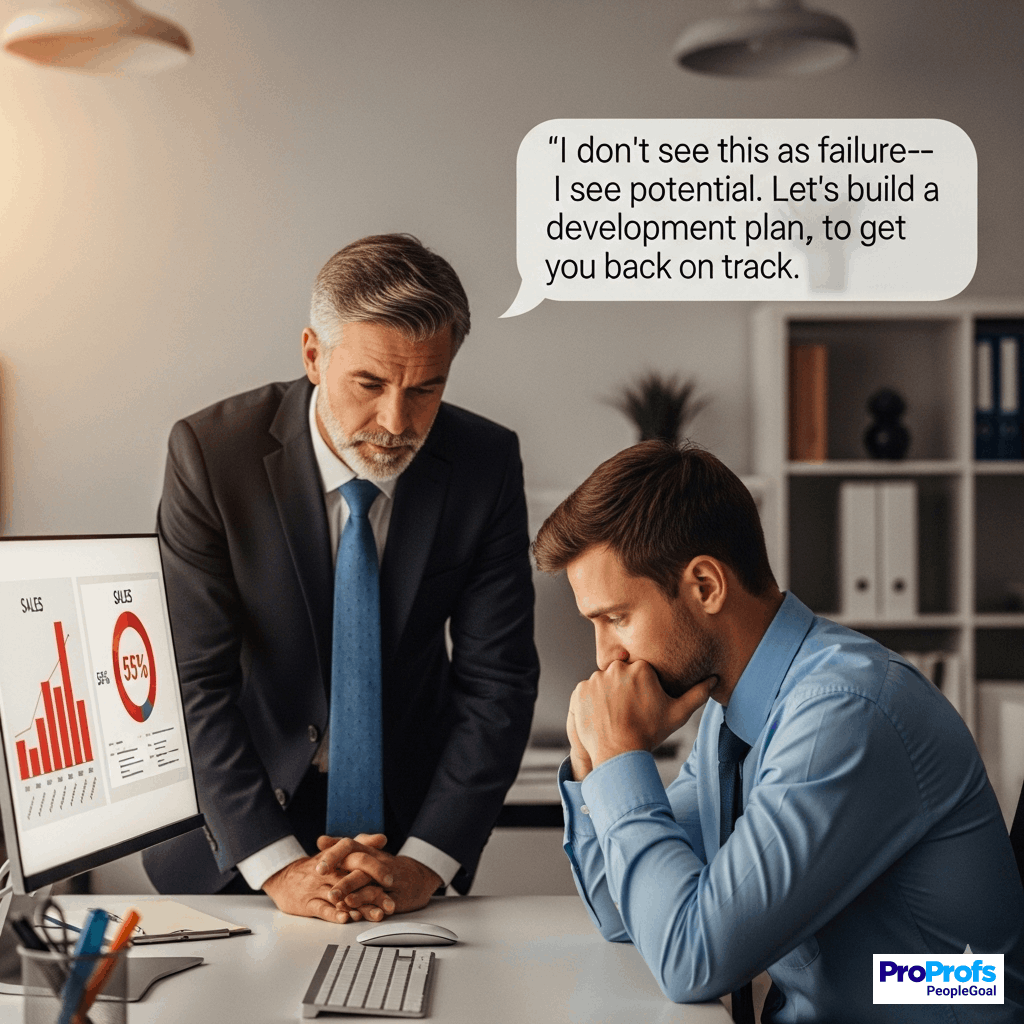
Employee Name: [Redacted]
Department/Team: Sales
Manager Name: [Myself]
Review Period: 3 Months
A. Goals
- Reach at least 80% of sales target by the end of Month 3.
- Improve client presentation skills from 2/5 to 4/5 on manager evaluation scale.
- Build confidence in leading meetings without relying on colleagues.
B. Development Actions
| Action | Resource/Support | Timeline | Status |
| Attend a public speaking workshop | Local training provider | Month 1 | Completed |
| Weekly role-plays with mentor | Senior sales executive | Months 1–3 | Ongoing |
| Participate in one live client pitch per week | Assigned by the manager | Months 1–3 | Ongoing |
| Structured feedback session after each pitch | Mentor & Manager | Weekly | In Progress |
C. Before and After Data
| Metric | Before Plan | After 3 Months |
| Sales Target Attainment | 55% | 82% |
| Presentation Skills (Manager Rating) | 2/5 | 4/5 |
| Client Meeting Confidence (Self-Assessment) | Low | High |
D. Manager Comments
The turnaround was clear. By Month 2, his presentations were more confident, and by Month 3, he had achieved over 80% of his sales target. The structured mix of training, mentorship, and live practice gave him both skills and belief in himself.
What struck me most was something he said in our final review: “I felt like someone finally invested in me, and that made me want to invest in myself.” That line captured the true value of development over correction.
Instead of demotivating him with a PIP, the plan gave him direction and ownership of his growth.
That’s interesting, right?
But after setting up plans and running them for different employees, the next big question every leader asks is: how do we know if it is working?
Without tracking outcomes, an employee development plan can feel like a good idea on paper but fail to show value in practice. That is why measuring progress and proving ROI is essential.
Measuring Success and ROI of Employee Development Plans
When I scale plans across teams, I always treat them like any other business initiative: they need metrics, systems, and visible outcomes.
Whether you are running an employee development program or even a broader workforce development plan, the principle remains the same: track what matters and tie it back to organizational goals.
1. Define Success Metrics Upfront
Every plan should have measurable outcomes. Some of the most effective metrics I’ve used include:
- Employee retention rates before and after the program. A manufacturing client reduced turnover by 11% after aligning development plans with succession opportunities.
- Employee engagement survey scores, especially around career progression and manager support.
- Internal promotion rates, which show whether a career development plan for employees is producing leaders.
- Project delivery or productivity data, such as improved cycle times after targeted training.
2. Use Feedback and Reviews as Indicators
Numbers alone don’t capture the full story.
I’ve often relied on structured one-on-one meetings and peer reviews to understand if development efforts are building confidence and competence.
Comments from employees like, “I finally see where I’m going here,” are early indicators of long-term loyalty.

3. Integrate With Tools and Systems
Consistency is only possible with systems.
Platforms such as PeopleGoal make it easier to log goals, document check-ins, and review progress across an entire company.
I’ve used such tools to turn individual plans into a repeatable employee development program without losing visibility into results. They allow leaders to compare team progress, see where skills gaps remain, and plan succession with confidence.
4. Calculate ROI in Practical Terms
Return on investment doesn’t need to be complicated. I usually calculate it by comparing the cost of development (training, coaching hours, tool subscriptions) with savings from reduced turnover, higher productivity, or faster promotions. For example:
- Cost of training + mentorship = $15,000
- Savings from avoiding two replacements due to improved retention = $40,000
- Net ROI = $25,000 in value
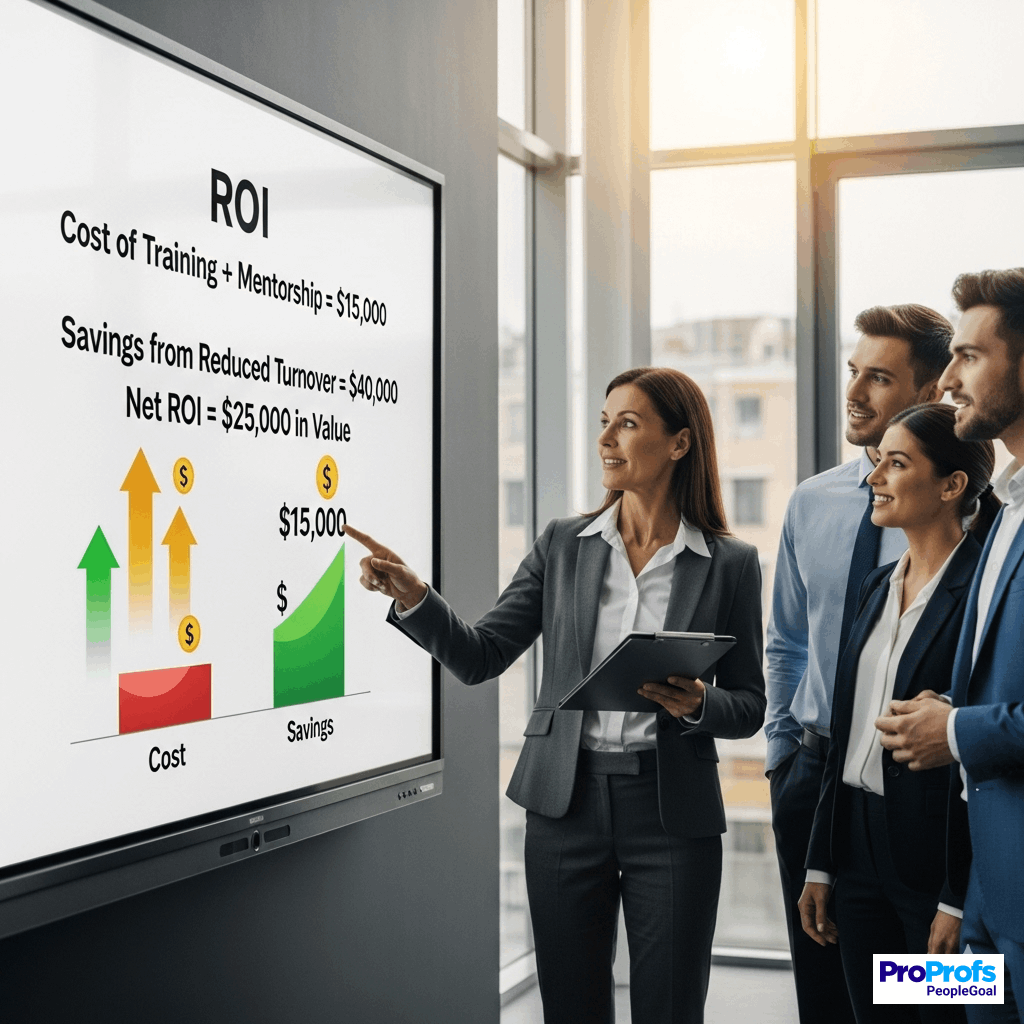
5. Tell the Story Beyond the Numbers
Metrics convince executives, but stories inspire the workforce.
Sharing real examples of employees who moved into new roles or teams that improved results because of development makes the program human.
One senior engineer told me, “The development plan gave me direction I didn’t know I needed.” Quotes like these show that the impact goes beyond charts.
And this brings me to the wrap-up.
Driving Growth Through Smarter Employee Development Plans
When I look back at the most successful teams I’ve managed, the common thread has always been structured development. A well-designed employee development plan is not just paperwork but a roadmap connecting business goals with employee aspirations.
By setting clear objectives, tracking progress, and adjusting regularly, you create an environment where people grow and the company thrives.
I’ve seen firsthand how these plans reduce turnover, improve engagement, and prepare future leaders. But none of this is sustainable without the right systems.
That’s why I recommend using dedicated employee development software. These tools make it simple to scale, track, and refine your employee development program so growth is consistent and measurable across the entire organization.
Frequently Asked Questions
2. How often should employee development plans be updated?
Development plans should be reviewed monthly and formally updated on a quarterly basis. Monthly check-ins capture smaller wins and address challenges early, while quarterly reviews keep goals aligned with evolving business priorities. This balance provides momentum, prevents stagnation, and ensures employees continue to receive timely feedback and direction throughout the year.
3. How is an employee development plan different from a training plan?
A training plan is focused on specific skills or courses, while an employee development plan takes a broader approach. Development plans combine training with mentorship, coaching, stretch projects, and performance feedback. Training builds immediate capabilities, whereas development ensures long-term growth, career advancement, and stronger alignment with overall organizational strategies and succession needs.
4. Can employee development plans improve retention?
Yes. Development plans demonstrate that an organization values growth and long-term careers. By providing clarity, structured opportunities, and measurable goals, employees feel invested in and supported. This sense of purpose and progression increases job satisfaction and loyalty, which directly reduces turnover and creates a more engaged and stable workforce over time.
5. What role does software play in employee development plans?
Software ensures consistency, visibility, and scalability. Platforms like PeopleGoal help organizations track goals, schedule check-ins, and document feedback in one place. For leaders, these tools provide clear data on ROI and succession readiness. For employees, they offer transparency, structure, and continuous alignment between individual growth and organizational objectives.
Ready to 3x Your Teams' Performance?
Use the best performance management software to align goals, track progress, and boost employee engagement.






